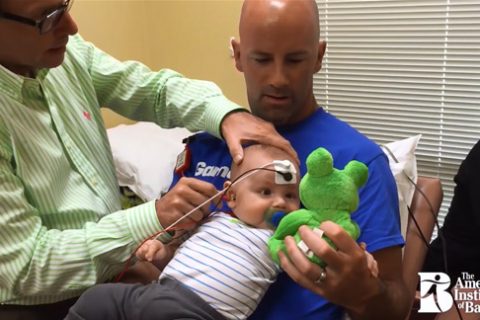
CASO DE ESTUDIO con VIDEO: cVEMP – EL MEJOR EXAMEN PARA BEBES
Published on: November 23, 2015
A la edad de 3-4 meses, típicamente la musculatura del cuello es lo suficiente fuerte para proveer soporte y permitir el uso del examen Vestibular Miogénico Potencial (cVEMP) con certeza. Pero la pregunta es, ¿para qué examinar un bebe? La literatura muestra claramente las comorbilidades de la pérdida de audición neurosensorial (Sensorineural Hearing Loss) y alteraciones vestibulares, por eso es nuestra opinión y protocolo en AIB que todos los infantes con SNHL deben ser examinados con el cVEMP. El desarrollo de su hito motor también debe vigilarse con atención para revelar retrasos importantes, por ejemplo, a qué edad controla la cabeza, se sienta independientemente, gatea, etc. También es importante recordar que de los 500 síndromes conocidos y trastornos mitocondriales, la mayoría tienen una mayor prevalencia vestibular en vez de auditiva. Cualquier niño con desarrollo motor retrasado debe considerarse en riesgo y por lo menos examinarse con el cVEMP.
En este vídeo, podrán ver una de las técnicas más sencillas utilizadas con un lactante de 4 meses. Nuestra experiencia es que el cVEMP es rápido, confiable y fácil de obtener en los bebés. A diferencia de BAER, el niño es examinado mejor cuando se encuentra despierto y activo, ya que necesitamos que se contraiga el músculo esternocleidomastoideo (ECOM), al mismo tiempo el cVEMP da una respuesta negativa del EMG. Normalmente utilizamos protocolos que incluyen la participación de los padres o también como lo puede ver en el segundo segmento jugueteando con el niño a para obtener el ECOM.
Referencias:
1. Gans, R.E., Evaluation and Management of Vestibular Function in Infants and Children with Hearing Loss, In Madell, J.R. and Flexer, C., (2014) Pediatric Audiology Diagnosis, Technology and Management, Thieme Medical Publishers, Inc. New York.
.2 Picciotti PM, Fiorita A, DiNardo W, Calò L, Scarano E, Paludetti G. (2007) Vestibular evoked myogenic potentials in children. Int J Pediatr Otorhinolaryngol 71:29–33.
3. Sheykholesami K, Kaga K, Megerian, CA. Arnold JE. (2005) Vestibular-evoked myogenic potentials in infancy and early childhood. Laryngoscope 115:1440–1444.
4. Zhou G, Kenna MA, Stevens K, Licameli G. (2009) Assessment of saccular function in children with sensorineural hearing loss. Otolaryngol Head Neck Surg 135(1):40–44.
